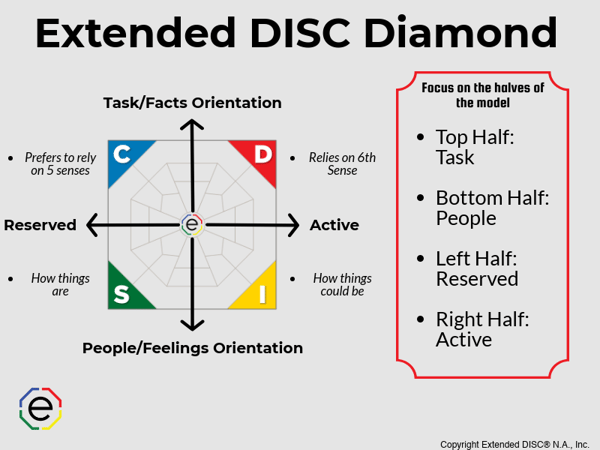Are you in the minority or majority if you have a combination of DISC styles?
If you're the one percent
 If you are 100% one DISC style then you happen to be in the minority. You have one style that is comfortable to you; at the same time you have three styles that are not comfortable to you. Now, it doesn't mean you don't have the other three styles. Your one natural style does not take energy; whereas, the other three, not natural styles, take energy.
If you are 100% one DISC style then you happen to be in the minority. You have one style that is comfortable to you; at the same time you have three styles that are not comfortable to you. Now, it doesn't mean you don't have the other three styles. Your one natural style does not take energy; whereas, the other three, not natural styles, take energy.
For example, if you are 100% I style then I-style behaviors are the ones you are naturally comfortable with. I-styles tend to be outgoing, more emotional, typically friendly, and love being the center of attention. You'll find it takes energy to push yourself outside the comfort zone of your I-style. For example, if you need to be quiet and listen, focus in on details, or make logical and detached decisions, you probably notice it takes more concentration and effort. However, it doesn't mean you can't or don't have the ability to do these things; it just means you have to focus and use energy because it's not natural to you; it's outside your comfort zone.
Only one percent of all people who take the Extended DISC® Assessment are 100% one DISC style; the rest of us are a combination of styles.
The rest of us
 Ninety nine percent of all people who take the Extended DISC® Assessments have a combination of DISC styles. In fact, the majority of people have three styles they are comfortable with. People with three styles account for approximately two-thirds of styles; whereas, people with two styles make up approximately one-third of styles. People who have a combination of styles simply identify multiple styles they find comfortable. However, we all have one predominant style which is more comfortable to us.
Ninety nine percent of all people who take the Extended DISC® Assessments have a combination of DISC styles. In fact, the majority of people have three styles they are comfortable with. People with three styles account for approximately two-thirds of styles; whereas, people with two styles make up approximately one-third of styles. People who have a combination of styles simply identify multiple styles they find comfortable. However, we all have one predominant style which is more comfortable to us.
We describe your styles in order of their dominance. For example, if you are a DC style, a combination of D and C styles, then D-style is your dominant style followed by C-style. You likely operate in your D-style comfort zone, but you can transition to your secondary C-style without additional energy. It also means the I-style and S-style are the styles that require energy from you.
Examples of 99% of us
 Do you find interacting with people exhilarating and exhausting at different times? You enjoy socializing, but sometimes you just want to recharge with close friends. Your close friends are most likely to see your bubbly and chatty side. They even mention how easy and fun it is to be around you. After work or at the end of the work week you either feel a need to recharge with those friends or see it as the start of weekend fun. At the office, you're likely to plan the office parties, but when it's all done you may tiredly wonder why you volunteered. If you are selectively social or sometimes confused as the 100% talkative and outgoing I-style then you may be a combination of S-style and I-style.
Do you find interacting with people exhilarating and exhausting at different times? You enjoy socializing, but sometimes you just want to recharge with close friends. Your close friends are most likely to see your bubbly and chatty side. They even mention how easy and fun it is to be around you. After work or at the end of the work week you either feel a need to recharge with those friends or see it as the start of weekend fun. At the office, you're likely to plan the office parties, but when it's all done you may tiredly wonder why you volunteered. If you are selectively social or sometimes confused as the 100% talkative and outgoing I-style then you may be a combination of S-style and I-style.
Do you know a person who is less emotional and focused primarily on tasks? They are likely one of the task-oriented styles, D-style or C-style. You've further observed their patterns of behaviors to identify them as a D-style. You know the best way to improve your interactions with your D-style is to pick up the pace, focus on the task, and don't be too chatty. Your interactions are improving, but you continue to refine your observations. You've observed how they tend to know what they want and how to actually do it. They excel at creating and building, but they only like doing things their way. You get frustrated because they don't ask for anyone's input. They are logical thinkers and are motivated by having information and challenging tasks. You are most likely interacting with someone who is a combination of D-style and C-style.
A useful tip for interacting with most of us
 We strive to improve interactions with others and we start this by identifying a person's dominant style, without over-reaching to identify their second and possibly third style. However, you constantly refine your observations as you learn more about them. If you know the person has a combination of three styles, what adjustments should you try to make? Let's say they are a combination of ISC styles, specifically 35% I-style, 35% S-style, and 30% C-style. They appear to be comfortable across the three styles. How should you adjust?
We strive to improve interactions with others and we start this by identifying a person's dominant style, without over-reaching to identify their second and possibly third style. However, you constantly refine your observations as you learn more about them. If you know the person has a combination of three styles, what adjustments should you try to make? Let's say they are a combination of ISC styles, specifically 35% I-style, 35% S-style, and 30% C-style. They appear to be comfortable across the three styles. How should you adjust?
One way is to consider focusing on the style you know they are not comfortable with over the styles they are. For example, if you know the person is more reserved, but at times friendly and people-oriented then try focusing on the style you know they are likely not; in this case, most likely D-style. If you modify your style to avoid aggressively competing, focusing only on yourself, or trying to dominate the interactions then you're still likely to succeed with them.
How does your combination of styles impact your interactions?
 We identify a person's style to have a starting point for better interactions. The more information we have about others, the more successful we can be. If we know they are a S-style, then we can make adjustments to be more patient, build rapport, and avoid sudden changes. However, we are only focusing on one style when they are likely to be a combination of styles. Upon further observation, we establish they're a combination of S, I, and C profiles. First off, we know this person is a dominant S, but they have a wider range of behaviors they are comfortable with. In social situations or facilitating a training they can bring out their I-style without additional energy or in situations when they need to focus on budgets and data, the C-style is more likely to show up. However, when the specific environmental pressures are no longer present, they will rest comfortably in their dominant S-style.
We identify a person's style to have a starting point for better interactions. The more information we have about others, the more successful we can be. If we know they are a S-style, then we can make adjustments to be more patient, build rapport, and avoid sudden changes. However, we are only focusing on one style when they are likely to be a combination of styles. Upon further observation, we establish they're a combination of S, I, and C profiles. First off, we know this person is a dominant S, but they have a wider range of behaviors they are comfortable with. In social situations or facilitating a training they can bring out their I-style without additional energy or in situations when they need to focus on budgets and data, the C-style is more likely to show up. However, when the specific environmental pressures are no longer present, they will rest comfortably in their dominant S-style.
We are complex and we all have styles we tend to be more comfortable with and styles which take more energy and focus for us. There is no style which is better or worse; we are simply different. Our behavioral style predicts how we prefer to do things so we can make conscious decisions about how to to adjust our style. The bottom line to successful interactions for 100% of us is that we have preferred ways of doing things and we have control over how we interact with others.
